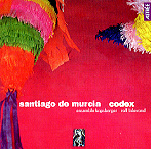The music on this fascinating program comes from an 18th century “guitar book” known as the Saldivar Codex No. 4, written by an important but almost totally neglected Spanish composer, Santiago de Murcia. As proved by these incredibly varied and original compositions, Murcia was no ordinary craftsman: he was an inventive genius of sorts who successfully accomplished what today we might call “fusion”, in this case bringing together aspects of Spanish, French, Italian, North African, and South American popular and classical forms to create something new. Murcia is thought to have spent time in Mexico and that’s where this Saldivar manuscript was discovered in the 1940s. The music arises primarily from dance forms–fandango, folias, tarantela, canarios, jacaras–and if you can keep from moving to the groove during the opening “fandango”, you’re due for a checkup.
It’s important to remember that while we may refer in general to the “Baroque guitar”, the guitar “family” includes a number of related stringed instruments used both in Europe and the Americas; and while we appreciate the appearance of written notes on a page of music, for many types of Baroque works these notes were a guide to improvisation–a practice thoroughly understood by contemporary musicians. The Ensemble Kapsberger and its visionary leader/virtuoso guitarist Rolf Lislevand observe both of these principles with authoritative scholarship and outstanding musicianship, their aim being “to reconstruct not only an authentic performance style, but also create a moment of particular inspiration.” Using several types of plucked strings–including Baroque guitars, vihuela, and colascione (a three-string bass lute from Italy)–an occasional contribution from the organ, and various percussion instruments, the eight-member ensemble gives a performance that never lets up in fulfilling that goal. The arrangements and improvisations sound so idiomatic that it’s impossible to tell what’s Murcia and what’s Lislevand & Co; and the sound allows us to hear every intricate fingering and every percussive snap and thud. Modern ears used to Latin rhythms and instruments will be right at home. Sometimes I believe that certain composers remain neglected because they’re waiting for just the right interpreters to come along and bring them to life. Murcia is lucky enough at last to have found his.
































